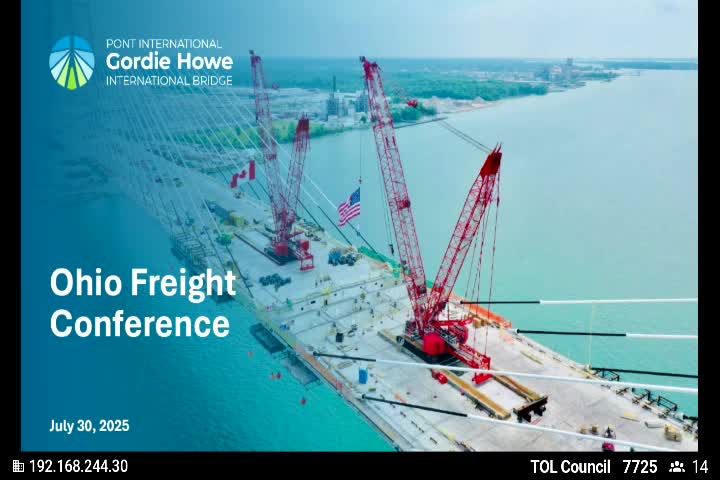New Ambassador Bridge Enhances Customs Clearance and Traffic Flow Between US and Canada
August 06, 2025 | Toledo, Lucas County, Ohio
This article was created by AI summarizing key points discussed. AI makes mistakes, so for full details and context, please refer to the video of the full meeting. Please report any errors so we can fix them. Report an error »

The Gordie Howe Bridge project is set to revolutionize cross-border traffic between the U.S. and Canada, as highlighted in the recent Toledo Finance, Debt & Budget Oversight Committee meeting. The bridge, which boasts a mile-and-a-half span, will enhance customs clearance and significantly improve transportation efficiency for freight and passenger vehicles alike.
Key discussions centered on the bridge's capacity to alleviate congestion at the Ambassador Bridge, currently the primary land port to Canada. With its six lanes expandable to eight, the Gordie Howe Bridge is designed to accommodate current and future traffic demands. This flexibility is crucial, as truck drivers have reported rerouting to other ports when faced with delays at the Ambassador Bridge, potentially stifling economic growth in Northwest Ohio.
The bridge will not only streamline freight movement but also cater to pedestrians and cyclists with a dedicated multiuse path, a first for the region. This path will feature its own customs clearance area, allowing for a seamless crossing experience for non-motorized travelers. The bridge's design includes advanced traffic management systems, enabling lane adjustments based on real-time traffic flow, which is expected to minimize backups and enhance overall efficiency.
The meeting also emphasized the importance of the bridge's customs area, which spans 167 acres on the U.S. side and is equipped with state-of-the-art inspection facilities. This includes the ability to X-ray two trucks simultaneously, significantly reducing wait times for commercial traffic. The integration of various inspection agencies on-site will further expedite the customs process, making it a game changer for cross-border trade.
As the Gordie Howe Bridge nears completion, its anticipated impact on local economies and transportation networks is profound. With improved access to Canadian markets, businesses in Northwest Ohio are poised to thrive, fostering growth and connectivity in the region. The bridge is not just a structure; it represents a vital link that will enhance trade, travel, and community engagement across borders.
Key discussions centered on the bridge's capacity to alleviate congestion at the Ambassador Bridge, currently the primary land port to Canada. With its six lanes expandable to eight, the Gordie Howe Bridge is designed to accommodate current and future traffic demands. This flexibility is crucial, as truck drivers have reported rerouting to other ports when faced with delays at the Ambassador Bridge, potentially stifling economic growth in Northwest Ohio.
The bridge will not only streamline freight movement but also cater to pedestrians and cyclists with a dedicated multiuse path, a first for the region. This path will feature its own customs clearance area, allowing for a seamless crossing experience for non-motorized travelers. The bridge's design includes advanced traffic management systems, enabling lane adjustments based on real-time traffic flow, which is expected to minimize backups and enhance overall efficiency.
The meeting also emphasized the importance of the bridge's customs area, which spans 167 acres on the U.S. side and is equipped with state-of-the-art inspection facilities. This includes the ability to X-ray two trucks simultaneously, significantly reducing wait times for commercial traffic. The integration of various inspection agencies on-site will further expedite the customs process, making it a game changer for cross-border trade.
As the Gordie Howe Bridge nears completion, its anticipated impact on local economies and transportation networks is profound. With improved access to Canadian markets, businesses in Northwest Ohio are poised to thrive, fostering growth and connectivity in the region. The bridge is not just a structure; it represents a vital link that will enhance trade, travel, and community engagement across borders.
View full meeting
This article is based on a recent meeting—watch the full video and explore the complete transcript for deeper insights into the discussion.
View full meeting
